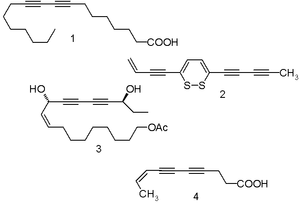- Polyyne
-
The polyynes are a group of organic compounds with alternating single and triple bonds. The simplest example is diacetylene or buta-1,3-diyne, HC≡C-C≡CH.
Along with cumulenes, polyynes are distinguished from other organic chains by their rigidity, which makes them promising for molecular nanotechnology. Polyynes are found in interstellar molecular clouds where hydrogen is scarce.
The longest reported (synthetic) polyyne to-date contains 22 acetylenic units and is end-capped with triisopropylsilyl groups [1]. The polyyne of infinite length is the elusive compound called carbyne; Linear acetylenic carbon is one of the carbon allotropes [2]
Contents
Natural occurrence
In plants
Naturally occurring polyynes exist,[3] and many are associated with medicinal properties. The acetylenic fatty acid 1 (scheme 1) is isolated from the root bark of the legume Paramacrolobium caeruleum of the Showy Mistletoe (Loranthaceae) family. The stems and leaves of members of this family have been used for the treatment of cancer in Indonesia.
The naturally occurring pigment thiarubrine B (2) has been isolated from the Giant Ragweed (Ambrosia trifida). Plants containing this type of compound have been used to treat skin infections and intestinal parasites by native people in Africa and Canada.
The inner bark and roots of Devil's club (Oplopanax horridus) is used by native Americans to treat a variety of ailments. One of the polyynes isolated is oplopandiolacetate (3). Dihydromatricaria acid (4) is a polyyne obtained from the soldier beetle. Other polyynes from plants include oenanthotoxin, cicutoxin, and falcarinol.
Because of the potential medicinal properties of these polyynes, their synthetic pathways are being studied with the hope that these can be replicated industrially by organic synthesis. Many such procedures involve a Cadiot–Chodkiewicz coupling.
In space
The octatetraynyl radicals and hexatriynyl radicals together with their ions are detected in space where Hydrogen is rare. See Astrochemistry.
See also
References
- ^ Synthesis of polyynes to model the sp-carbon allotrope carbyne Wesley A. Chalifoux1 & Rik R. Tykwinski Nature Chemistry 2, 967 - 971 (2010) | doi:10.1038/nchem.828
- ^ Synthesis of extended polyynes: Toward carbyne Wesley A. Chalifouxa and Rik R. Tykwinsk Comptes Rendus Chimie Volume 12, Issues 3-4, March-April 2009, Pages 341-358 Avancés récentes en chimie des acétylènes - Recent advances in acetylene chemistry doi:10.1016/j.crci.2008.10.004
- ^ Annabelle, L. K.; Shi Shun; Tykwinski, Rik R. (2006). "Synthesis of Naturally Occurring Polyynes". Angewandte Chemie International Edition 45 (7): 1034–1057. doi:10.1002/anie.200502071. PMID 16447152.
Categories:- Alkynes
- Astrochemistry
Wikimedia Foundation. 2010.

